Tenacious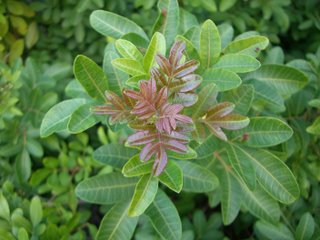
This lovely maroon leaf, sprouting and growing now, in late December, a week before winter's solstice, has a long history here in Florida. Florida holly, Christmas plant, Brazilian pepperweed, (
Schinus terebinthifolius), has a
history, rather than an ecology. It came late to this state, in the 1800s from South America, from the birthplace of my soulmate, from Argentina. An entrepreneurial chap in Bradenton, Florida, just south of here, decided it would make a nice holiday plant; its bright red berries and dark green leaves fruited just at Christmastime; it had the appearance of the season. And so it spread, hand to hand, beak to soil. Today, if my observations do not fail me, it is replanted daily by ravenous masked rodents. They bite off a mouthful of berries and release them complete with fertilizer some few hours later. Some time in the 1960s it reached what might be called a critical mass down here
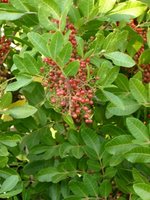
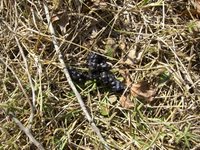
on this peninsula, this heap of sand, this Florida; it invaded every piece of farm field left to the state and to the nation during the land conservation craze of those years. And since then, it has perplexed land managers and nature lovers alike. It is unique in its qualities. It grows almost constantly throughout the year, except late fall to early winter. It can sprout from its stump, and do so with a wild explosion of branches making a cut stump a worse enemy than an old tree.
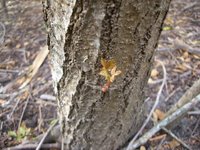
And it produces, as it was brought here to do, an enormous load of colorful fruit every year at Christmastime, feeding our wintering bird population and hungry racoons and setting about an annual cycle of cultivation. It grows faster than anything around it and has an incredible plasticity of form, allowing it to overtop any reasonably sized canopy and shoot through the top. It has been classified, and rightly so in this instance for mostly the right reason, as an "invasive" plant. It dominates the plant communities where it grows, shading out everything but the dogged cabbage palm (
Sabal palmetto) and an occassional intrepid live oak.
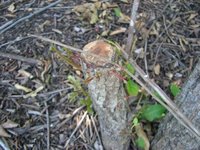
It is beautiful, a plant with charm and attractiveness to the eye, but a plant with no sense of equity or fairness. It does not understand the need for cooperation, it overproduces fiber and berry and pushes itself out into every available nook and cranny and extends it arms in every possible direction. It holds a good sized bird population during daytime in its shaded understory, and armoured beetles in its roots and leaf layers. But it recreates what can only be called a sickly pale substitute for the possible variety and variation in a plant community like our palm hammock. It does not share and it does not care to.
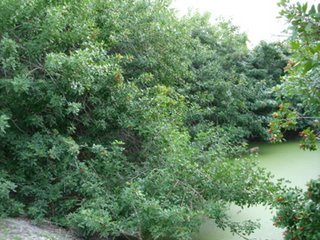
There is more to say on this matter, but for now rest it at this: I have been waging a quiet battle against this tenacious species. Its spirit and tendencies are not good metaphors, they do not teach our children well, and so we work to limit its influence. It is us, no question. It is our hands, our motives, our ceaseless desire to have whatever our impulses make us think we want; and so the work against it is hard work, endless work for a lonely soul. Work that requires patience and care and work that will draw us out of a failed paradigm. I believe that this is what
Schinus can ultimately bequeath us, if we give it the right attention.
 This lovely maroon leaf, sprouting and growing now, in late December, a week before winter's solstice, has a long history here in Florida. Florida holly, Christmas plant, Brazilian pepperweed, (Schinus terebinthifolius), has a history, rather than an ecology. It came late to this state, in the 1800s from South America, from the birthplace of my soulmate, from Argentina. An entrepreneurial chap in Bradenton, Florida, just south of here, decided it would make a nice holiday plant; its bright red berries and dark green leaves fruited just at Christmastime; it had the appearance of the season. And so it spread, hand to hand, beak to soil. Today, if my observations do not fail me, it is replanted daily by ravenous masked rodents. They bite off a mouthful of berries and release them complete with fertilizer some few hours later. Some time in the 1960s it reached what might be called a critical mass down here
This lovely maroon leaf, sprouting and growing now, in late December, a week before winter's solstice, has a long history here in Florida. Florida holly, Christmas plant, Brazilian pepperweed, (Schinus terebinthifolius), has a history, rather than an ecology. It came late to this state, in the 1800s from South America, from the birthplace of my soulmate, from Argentina. An entrepreneurial chap in Bradenton, Florida, just south of here, decided it would make a nice holiday plant; its bright red berries and dark green leaves fruited just at Christmastime; it had the appearance of the season. And so it spread, hand to hand, beak to soil. Today, if my observations do not fail me, it is replanted daily by ravenous masked rodents. They bite off a mouthful of berries and release them complete with fertilizer some few hours later. Some time in the 1960s it reached what might be called a critical mass down here 
 on this peninsula, this heap of sand, this Florida; it invaded every piece of farm field left to the state and to the nation during the land conservation craze of those years. And since then, it has perplexed land managers and nature lovers alike. It is unique in its qualities. It grows almost constantly throughout the year, except late fall to early winter. It can sprout from its stump, and do so with a wild explosion of branches making a cut stump a worse enemy than an old tree.
on this peninsula, this heap of sand, this Florida; it invaded every piece of farm field left to the state and to the nation during the land conservation craze of those years. And since then, it has perplexed land managers and nature lovers alike. It is unique in its qualities. It grows almost constantly throughout the year, except late fall to early winter. It can sprout from its stump, and do so with a wild explosion of branches making a cut stump a worse enemy than an old tree.  And it produces, as it was brought here to do, an enormous load of colorful fruit every year at Christmastime, feeding our wintering bird population and hungry racoons and setting about an annual cycle of cultivation. It grows faster than anything around it and has an incredible plasticity of form, allowing it to overtop any reasonably sized canopy and shoot through the top. It has been classified, and rightly so in this instance for mostly the right reason, as an "invasive" plant. It dominates the plant communities where it grows, shading out everything but the dogged cabbage palm (Sabal palmetto) and an occassional intrepid live oak.
And it produces, as it was brought here to do, an enormous load of colorful fruit every year at Christmastime, feeding our wintering bird population and hungry racoons and setting about an annual cycle of cultivation. It grows faster than anything around it and has an incredible plasticity of form, allowing it to overtop any reasonably sized canopy and shoot through the top. It has been classified, and rightly so in this instance for mostly the right reason, as an "invasive" plant. It dominates the plant communities where it grows, shading out everything but the dogged cabbage palm (Sabal palmetto) and an occassional intrepid live oak.  It is beautiful, a plant with charm and attractiveness to the eye, but a plant with no sense of equity or fairness. It does not understand the need for cooperation, it overproduces fiber and berry and pushes itself out into every available nook and cranny and extends it arms in every possible direction. It holds a good sized bird population during daytime in its shaded understory, and armoured beetles in its roots and leaf layers. But it recreates what can only be called a sickly pale substitute for the possible variety and variation in a plant community like our palm hammock. It does not share and it does not care to.
It is beautiful, a plant with charm and attractiveness to the eye, but a plant with no sense of equity or fairness. It does not understand the need for cooperation, it overproduces fiber and berry and pushes itself out into every available nook and cranny and extends it arms in every possible direction. It holds a good sized bird population during daytime in its shaded understory, and armoured beetles in its roots and leaf layers. But it recreates what can only be called a sickly pale substitute for the possible variety and variation in a plant community like our palm hammock. It does not share and it does not care to.  There is more to say on this matter, but for now rest it at this: I have been waging a quiet battle against this tenacious species. Its spirit and tendencies are not good metaphors, they do not teach our children well, and so we work to limit its influence. It is us, no question. It is our hands, our motives, our ceaseless desire to have whatever our impulses make us think we want; and so the work against it is hard work, endless work for a lonely soul. Work that requires patience and care and work that will draw us out of a failed paradigm. I believe that this is what Schinus can ultimately bequeath us, if we give it the right attention.
There is more to say on this matter, but for now rest it at this: I have been waging a quiet battle against this tenacious species. Its spirit and tendencies are not good metaphors, they do not teach our children well, and so we work to limit its influence. It is us, no question. It is our hands, our motives, our ceaseless desire to have whatever our impulses make us think we want; and so the work against it is hard work, endless work for a lonely soul. Work that requires patience and care and work that will draw us out of a failed paradigm. I believe that this is what Schinus can ultimately bequeath us, if we give it the right attention.
No comments:
Post a Comment